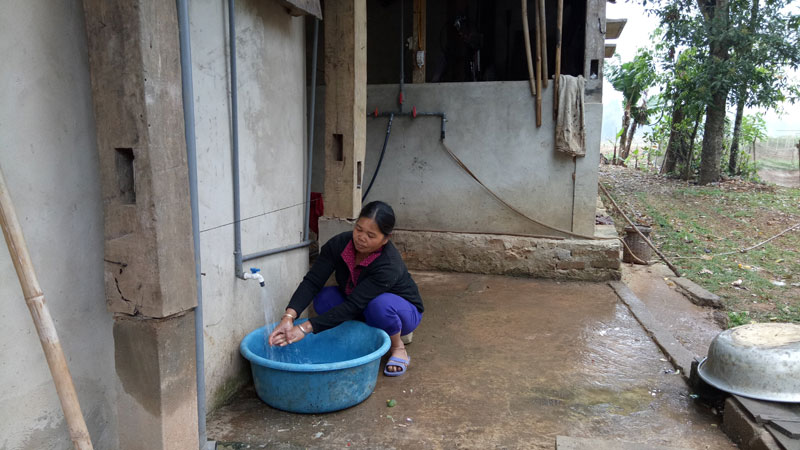
(HBO) – Over the past years, the northern province of Hoa Binh has effectively carried out the credit programme on clean water and environmental sanitation, contributing to improving local people’s living standards and rural environmental sanitation, and giving a facelift to rural areas.

Thanks to concessional loans from the Vietnam
Bank for Social Policies (VBSP), Ha Thi Kieu’s family in Cha hamlet, Tong Dau
commune, Mai Chau district, built a system of clean water and sanitation,
helping raise their living standards.
Vu Dinh Hoai, Director of the VBSP’s Hoa Binh
branch, said at the end of July, the province had 6,836 customers who took
loans worth more than 79.2 billion VND from the bank, increasing the total
outstanding balance to 389.9 billion VND owed by 35,709 households. Most of the
households have used the loans for right purposes.
Since the beginning of this year, the
households have built 6,863 clean water facilities and 6,836 sanitation
facilities such as water containers and filters, drilled wells, bathrooms and
toilets.
Thanks to such efforts, the rural environment
has been improved significantly, contributing to completing the environmental
criterion of new-style area building in hamlets and communes in the province.
The VBSP will continue to closely coordinate
with organisations and associations in localities to popularise credit policies
on clean water and rural environmental sanitation, creating conditions for
rural residents to approach preferential loans to build clean water and
sanitation facilities. At the same time, the bank will step up efforts to
collect debts and interest rates as scheduled to help other households access
loans.
Thanks to integrated loans, localities in the
province built hundreds of centralised clean water facilities. Up to 90 percent
of rural residents get access to clean water and over 70 percent of rural
households have hygienic toilets. Meanwhile, more than 60 percent of breeding
facilities meet sanitation requirements.
At the end of 2017, 79 out of the 191
communes in the province fulfilled the environment-related criterion in
new-style rural area building.
The Department of Education and Training of Hoa Binh province held a conference on March 18 to review the performance of the "Safe and Happy School" Project and set out tasks for 2025. The project, funded by the Taiwan Fund for Children and Families (TFCF), aims to create a safe, inclusive, and supportive learning environment for students. The event saw the attendance of representatives from the TFCF and 26 beneficiary schools.
With over 70% of their workers being women, trade unions across industrial parks (IPs) in Hoa Binh have been actively safeguarding their legal rights and interests while implementing initiatives to improve their income and well-being.
In recent years, the Hoa Binh provincial General Hospital has continuously innovated itself and improved the quality of medical services to meet the increasing needs of local people. With substantial investments in infrastructure and modern equipment, along with a team of highly qualified doctors and nurses, the hospital has gradually established itself as one of the leading medical units in the Northwestern region and a trusted destination for healthcare for people inside and outside the province.
From mastering the fundamentals of programming to achieving national recognition, the Programming Club of the Le Van Tam Primary School (STAR LVT28) in Hoa Binh city has made remarkable strides in the field of robotics.
The Ho Chi Minh Communist Youth Union Committee and the Vietnam Youth Federation chapter of Hoa Binh province organised a programme on March 12 to launch the "Digital Literacy" movement and an online quiz on the resolutions of the Vietnam Youth Federation congresses at all levels, as well as the Politburo's Resolution No. 57-NQ/TW on breakthroughs in the development of science, technology, innovation, and national digital transformation.
As climate change grows more unpredictable, the development of production forests has become essential - not just for economic growth, but for safeguarding the environment and maintaining ecosystem balance. By boosting local incomes, curbing natural disasters, preventing soil erosion, and protecting water resources, these forests play a crucial role in sustainable development.



